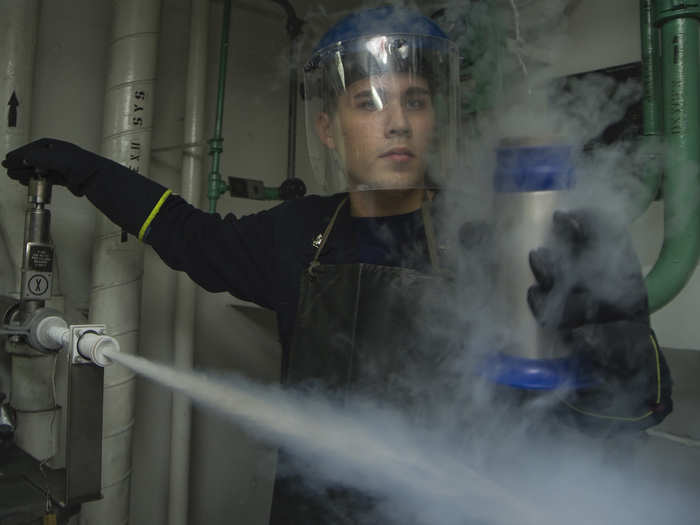
!["The main ways that machinist's mates and engineering department support naval aviation is through the catapult shop and [oxygen and nitrogen] shop," said Huizar. "The main ways that machinist's mates and engineering department support naval aviation is through the catapult shop and [oxygen and nitrogen] shop," said Huizar.](/thumb/msid-60085318,width-700,height-525/60085318.jpg)
"The catapult shop makes sure that all of the machinery is up to date and fully functioning in order to operate the catapult that launch the jets. As for [oxygen and nitrogen], we create aviator's breathing oxygen and we also have a cryogenic plant that creates liquid oxygen and liquid nitrogen. The liquid oxygen is used as aviator's breathing oxygen and the liquid nitrogen is used as gaseous nitrogen for the airplane tires because it expands and contracts less at various altitudes."

The air in the expansion engine is frozen to negative 320 degrees Fahrenheit to separate nitrogen, and negative 297 degrees Fahrenheit to separate oxygen.
Air separation is vital to the mission of George Washington, regardless of where the ship finds herself in her life cycle.
According to navy.mil, "O2N2 Plants Bring Life to Airwing Pilot," O2N2 plants provide oxygen to the aviators, nitrogen to the air wing, and gas forms of both for use throughout the ship.


"The machinist's mate is like the Swiss army knife of the Navy," said Pruitt. "Since being in the shipyards, we have repaired all four aircraft elevators, started the five-year catapult inspection, restored fire pumps to support Ready to Flood operations, and refurbished the air conditioner and refrigeration units."

 Should you be worried about the potential side-effects of the Covishield vaccine?
Should you be worried about the potential side-effects of the Covishield vaccine?
 India T20 World Cup squad: KulCha back on menu, KL Rahul dropped
India T20 World Cup squad: KulCha back on menu, KL Rahul dropped
 Sales of homes priced over ₹4 crore rise 10% in Jan-Mar in top 7 cities: CBRE
Sales of homes priced over ₹4 crore rise 10% in Jan-Mar in top 7 cities: CBRE

Copyright © 2024. Times Internet Limited. All rights reserved.For reprint rights. Times Syndication Service.